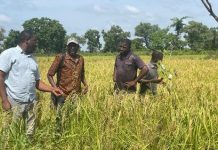By Kebba Jeffang
Rice growers at the Jahally and Patcharr rice fields have spoken to this medium about their plight and current situation. According to the farmers, there are underlying factors that have gone wrong, marking an end to the glory days when the rice grower would not know the cost of a bag of imported rice, due to bumper harvests in their stores.

The Jahally Patcharr rice field is situated in Lower Fulladu West district in Central River Region South. The rice field was established around 1982 and divided among several communities such as Jahally, Brikamaba, Saruja, Wellingara etc., as a source of survival for these rural communities. Cropping seasons during the glorious days of this rice field, has seen bumper harvests used by farmers for months from their stores. Initially, the source of water supply for the Jahally rice field was based on pumping machines that drew water from the nearby river Gambia.
With the intervention of the Taiwanese during the former regime, the mechanism of water supply was turned into tidal irrigation, whereby water supply to the field is based on low or high tide. Although this was embraced by many people, one farmer predicted in those days, that this will be a contributing factor to low harvest.
Sheriff Njie, the Field’s committee member responsible for overseeing the rice growing site, said the tidal system is what is actually contributing to low gains causing most farmers to go hungry with their families.
“We harvested our rice less than three months ago but no single farmer has a grain of the last harvest at home. It has all finished and this is the only hope for us. As I speak to you I have food shortage in my house and many are living the same condition. My harvest finished more than a month ago. I cultivated one hectare for subsistence purposes. I can’t sell what I produce because if I do, I would die of hunger. I cultivated one and a half plots and got 21 bags of rice. But everything has been consumed since a month ago,” he said.
The old man said the poor harvest is not only caused by the frequent flooding of the field, but many other factors contributed to the decline in bumper harvests such as the tidal irrigation system, lack of farm inputs such as machines and poor management by the previous committee members. He blamed his predecessors for their lack of knowledge in rice cultivation and for being unsympathetic to poor farmers. “This is what is tormenting us,” Njie stressed.
Njie recalled that flooding is not a factor to their predicament because rains before were intense than now, but harvest was far better than now.
“The cause has to do with the drainage system that is being used recently unlike before, when special machines were stationed at the field to remove excess water. This machine prevented the rice field from flooding. The amount of rains before was more than now. We used to cultivate the field both during the dry and rainy seasons with fruitful outcomes,” he said.
“In those days,’’ Njie continued, ‘‘during the rainy season, a farmer can harvest more than 80 bags from just one plot. And in the dry season, one can harvest over 100 bags of rice. I witnessed all this here because I have farmed here all my life. The gains have since continued to reduce consistently.”
He lamented the lack of farm implements such as tractors, vehicles, excavators, caterpillars and power tillers as the main contributor to the low harvest at Jahally rice field. Njie disclosed that there was no butut in the coffers of their farm association as he spoke to this medium. Njie explained that sponsors came from NGOs such as Action Aid and many other projects, but that those monies have never reached the farmers. Njie said if the new dispensation comes to the aid of Jahaly rice growers with farm inputs like tractors, excavators and fertilizer, including pumping machines, rice production will rejuvenate like the glory old days.
A middle aged- woman, Fatou Touray, who hails from Fulladu Darsilammeh attributed the poor harvest to the insufficient availability of fertilizer. She said many could not harvest 20 bags of paddy rice from one plot last season, due to the unavailability of fertilizer.
“We appeal to the new government to help us with ploughing machines and sufficient fertilizer so that we can embark on timely cultivation. We have a market but what we harvest cannot be sold because nothing will remain for family consumption. Right now, there is no harvest remaining at home. We are buying imported rice,” she said.
According to Touray, she could remember those days when her family would shun imported rice due to the availability of locally produced rice that was plentiful in their stores, for the whole season.
Another committee official responsible for water supply at the field said the recent failure of the cropping season was because of the destruction of the perimeter dike by the run-off flood waters. Sainey Jallow said the dike that was built around 1983, surrounds the field and prevents run-off water from reaching the plots to increase excess water supply. Jallow said this perimeter dike needs to be rebuilt in order to avoid continuous losses to production. ‘‘Due to the inundation of the rice field, it deterred farmers from making nursery beds before transplanting. It has come to a stage that we cannot cultivate the field. We need help because this place provides the survival means for many Gambians,’’ Njie said. The perimeter dike that surrounds the field is said to measure more than 10 kilometers and it was constructed around 1983, during the first republic. However, the Jahally rice growers are hopeful that the Jahally rice fields can go back to the glory days when the rice field used to be one of the bread baskets of the country, if the problems confronting production is solved. As at now, most heads of households, complain of food shortage.


















